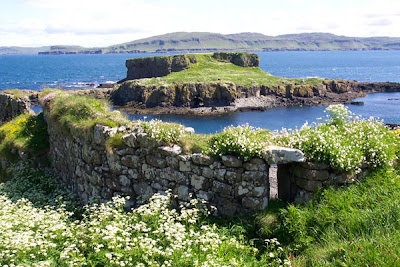
My picture I took on my trip. I did not go onto the Island.





Isle of "Cairn na Burgh Mòr" (means Cairnburgh More) is a tiny Island in the northern Treshnish Isles of Scotland in the Inner Hebrides. The island's location is north of Ulva, south of Coll and off the west coast of the Isle of Mull. I sailed right past the Island in 2006 on my journey with the Hebridean Whale and Dolphin Trust. The captain of my ship told me that historically and locally this is the place where the Vikings buried their loot and treasures that they stole from the Isle of Iona (Iona Abbey) and elsewhere during the 700s, 800s, 900s AD. The captain also told me that no one has ever found any treasures on the island however this is where it is suppose to be. Maybe one day someone will find treasure!
The island just by looking at it, you can tell it is very hard just to get on the island, it is totally surrounded by high cliffs! You might need some serious rock climbing training. The island is home to the ruins of Cairnburgh Castle and its chapel. There is also a well on the island. The Cairnburgh Castle's fortifications straddle both Cairn na Burgh Mor and its sister island Cairn na Burgh Beag. There is also a guard house on the smaller island of Beag. The castle on the Island may have began as a Viking fortress named "Kiarnaborg" as locally and historically this is where they held their loot and treasure. It was recorded as being one of the castles belonging to the Kingdom of Isles and Man under King Somerled in The Saga of Haakon Haakonarson. It was later recorded as property of the MacDougalls of Lorne, later the
MacDonalds owned it, then later it was owned by MacLeans of Duart. When the MacLeans rebelled in 1504, King James IV (1473 - 1513) besieged the castle. In the 1650's Oliver Cromwell's army took the fortress. Government troops during the Jacobite Rebellions were housed on this island's castle in the 1700s. This island now is nothing but a bird colony, it is home to thousands of birds but it has a long history very few know about. Today very few if anyone visits the island.